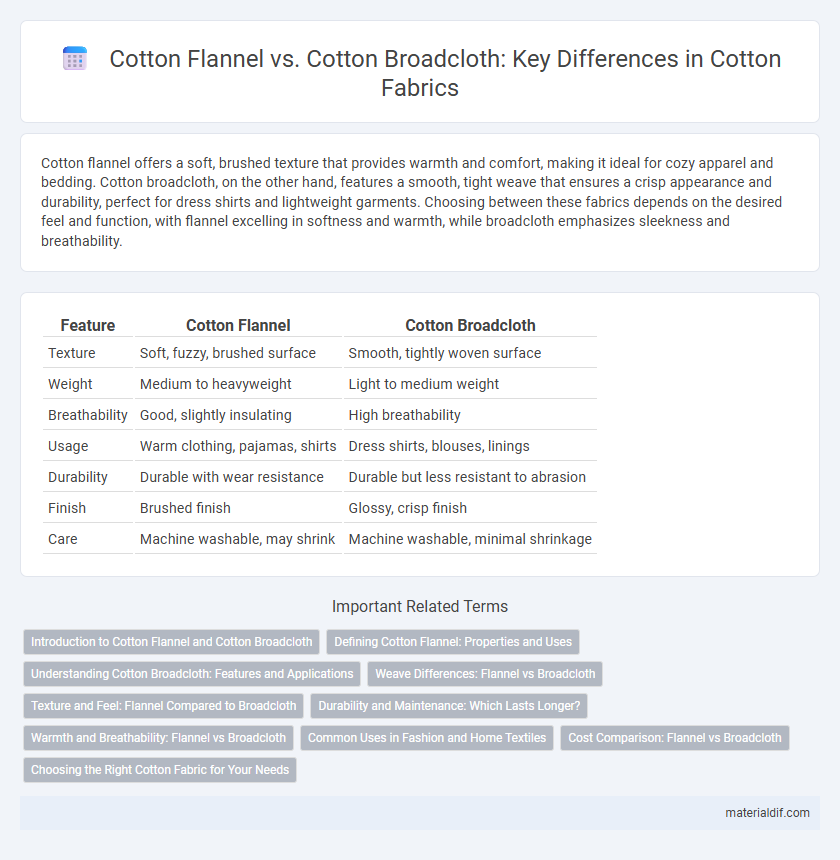Cotton flannel offers a soft, brushed texture that provides warmth and comfort, making it ideal for cozy apparel and bedding. Cotton broadcloth, on the other hand, features a smooth, tight weave that ensures a crisp appearance and durability, perfect for dress shirts and lightweight garments. Choosing between these fabrics depends on the desired feel and function, with flannel excelling in softness and warmth, while broadcloth emphasizes sleekness and breathability.
Table of Comparison
| Feature | Cotton Flannel | Cotton Broadcloth |
|---|---|---|
| Texture | Soft, fuzzy, brushed surface | Smooth, tightly woven surface |
| Weight | Medium to heavyweight | Light to medium weight |
| Breathability | Good, slightly insulating | High breathability |
| Usage | Warm clothing, pajamas, shirts | Dress shirts, blouses, linings |
| Durability | Durable with wear resistance | Durable but less resistant to abrasion |
| Finish | Brushed finish | Glossy, crisp finish |
| Care | Machine washable, may shrink | Machine washable, minimal shrinkage |
Introduction to Cotton Flannel and Cotton Broadcloth
Cotton flannel is a soft, brushed fabric known for its warmth and cozy texture, making it ideal for cold-weather clothing and bedding. Cotton broadcloth features a smooth, tightly woven surface with a crisp feel, commonly used in dress shirts and formal wear. Both fabrics showcase the versatility of cotton, yet differ significantly in texture and typical applications.
Defining Cotton Flannel: Properties and Uses
Cotton flannel is a soft, loosely woven fabric known for its brushed surface that provides warmth and a cozy texture, making it ideal for cold-weather clothing and bedding. It typically features a napped finish on one or both sides, which enhances its insulating properties and softness compared to smoother fabrics like cotton broadcloth. Widely used in casual shirts, pajamas, and blankets, cotton flannel balances comfort and functionality with its breathable cotton fibers and plush feel.
Understanding Cotton Broadcloth: Features and Applications
Cotton broadcloth is a tightly woven fabric known for its smooth texture and lightweight durability, making it ideal for formal shirts and dresses. Its fine, plain weave results in a crisp finish that resists wrinkles and maintains shape well during washing. Commonly used in high-quality apparel and bedding, cotton broadcloth offers breathability and comfort without sacrificing a polished appearance.
Weave Differences: Flannel vs Broadcloth
Cotton flannel features a brushed, twill weave that creates a soft, fuzzy texture ideal for warmth and comfort, making it popular for cold-weather clothing. In contrast, cotton broadcloth has a tight, plain weave with a smooth, crisp finish that offers durability and a polished appearance, commonly used in dress shirts and lightweight garments. The distinct weave structures impact the fabric's texture, breathability, and intended use, with flannel providing insulation and broadcloth delivering a sleek, refined look.
Texture and Feel: Flannel Compared to Broadcloth
Cotton flannel has a soft, brushed texture that provides warmth and a cozy, slightly fuzzy feel, making it ideal for cooler climates. In contrast, cotton broadcloth features a smooth and tightly woven surface with a crisp, lightweight feel, suitable for formal shirts and uniforms. The distinct textures result from flannel's loose weave and finishing process versus broadcloth's fine, plain weave construction.
Durability and Maintenance: Which Lasts Longer?
Cotton flannel, made from loosely woven fibers, offers softness but tends to wear out faster than tightly woven cotton broadcloth, which is known for its durability and resistance to fraying. Broadcloth's dense weave enhances its lifespan, making it less prone to pilling and shrinking during washing, whereas flannel requires gentler care to maintain its texture and shape. Choosing broadcloth ensures easier maintenance and longer-lasting fabric, ideal for garments subjected to frequent use and laundering.
Warmth and Breathability: Flannel vs Broadcloth
Cotton flannel offers superior warmth due to its brushed surface, which traps air and provides excellent insulation, making it ideal for colder climates. Cotton broadcloth is lighter and more tightly woven, enhancing breathability and moisture-wicking properties, suitable for warmer weather or layering. Choosing between flannel and broadcloth depends on the need for thermal insulation versus ventilation in cotton fabrics.
Common Uses in Fashion and Home Textiles
Cotton flannel is widely favored for cozy garments such as shirts, pajamas, and loungewear due to its soft, brushed texture that provides warmth and comfort. Cotton broadcloth, characterized by its fine, tightly woven fabric, is commonly used in dress shirts, blouses, and lightweight summer apparel for its smooth finish and crisp appearance. In home textiles, flannel finds popularity in bedding and blankets for insulation and softness, whereas broadcloth is often utilized in pillowcases, curtains, and table linens where durability and a clean look are desired.
Cost Comparison: Flannel vs Broadcloth
Cotton flannel generally costs more than cotton broadcloth due to its thicker weave and brushed texture, which require additional manufacturing processes. Broadcloth, being a lightweight, tightly woven fabric, tends to be more affordable and widely used for shirts and blouses. The price difference is influenced by factors such as fiber quality, fabric weight, and finishing techniques specific to flannel and broadcloth production.
Choosing the Right Cotton Fabric for Your Needs
Cotton flannel offers a soft, brushed texture ideal for warmth and comfort in cold-weather clothing and bedding, while cotton broadcloth provides a smooth, tightly woven surface perfect for crisp shirts and formal wear. Selecting the right cotton fabric depends on your desired breathability, texture, and durability, with flannel excelling in insulation and broadcloth standing out for its lightweight yet sturdy structure. Understanding these key differences ensures you choose a cotton fabric that aligns with specific project requirements, from casual comfort to polished style.
Cotton Flannel vs Cotton Broadcloth Infographic

 materialdif.com
materialdif.com